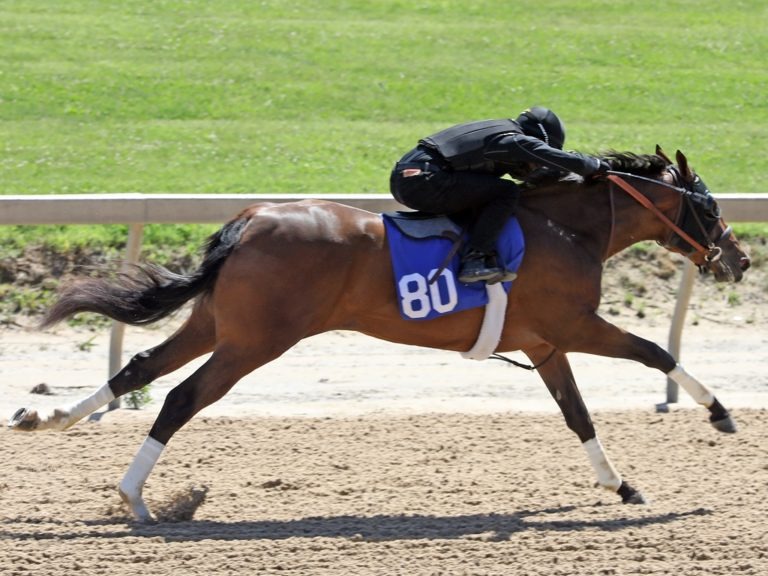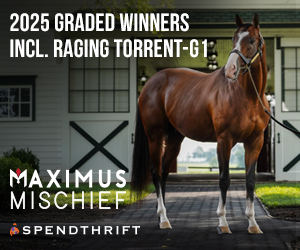
The BloodHorse, ever optimistic, reported that this week’s results from the Fasig-Tipton sale of two-year-olds in training at Timonium MD is “a sign that the juvenile market may be turning the corner.” In other words, the sale wasn’t quite as bad for sellers as the Ocala Breeders Sales Co. auction two weeks ago had been. What corner it is that the market is turning remains, however, to be seen.
Overall, 303 of the 563 horses in the Timonium catalog were sold, for a total of $23,572,500, or an average of just under $78,000 and a median price of $40,000. That compares to last year’s Timonium sale, held at its usual spot in the calendar just after the Preakness and undeterred by the coronavirus, when 326 juveniles sold for an average of just over $90,000 and a median price of $43,000.
At this week’s Timonium auction, 72 horses went through the ring but failed to meet their reserve, and another 188 were scratched. So roughly 54% of all the horses originally listed for sale actually found new homes. That’s better than at the two earlier 2YO sales this year, but well below the numbers for prior years.
And, as in. the case of the recent OBS sale, the Timonium numbers were inflated by the presence of premium horses that had been rerouted from the cancelled Fasig-Tipton Gulfstream sale, the industry’s top market for two-year-olds. At Timonium, 23 of the horses sold had originally been listed in the Gulfstream catalog. Those 23 brought an average price of $133,300, compared to roughly $74,000 for the non-Gulfstream offerings. Once the Gulfstream horses have been taken out of the calculations, we’re left with a decline of 17% from last year’s Timonium average.
Over the past several decades, two-year-old sales have evolved from a means of selling horses raised on the farms near Ocala – the original impetus for the formation of OBS – into a segment of the thoroughbred market that is principally the domain of “pinhookers” – consignors who buy weanlings or yearlings in order to sell, or at least try to sell, them a year or two later as two-year-olds. At this week’s Timonium sale, for example, 65% of all the horses sold were offered by pinhookers. If they are to have two-year-olds to sell next year, the pinhookers have to return to the yearling market, which in this year’s compressed timetable starts up again in just a few weeks. And, to buy those yearlings , the pinhookers need to have in hand the money they’ve made at the juvenile auctions. So, let’s see how pinhookers did at the Timonium sale. Spoiler alert: it was not a great year for pinhooking.
In total, there were 196 horses pinhooked horses (horses had previously been sold through a weanling or yearling auction) sold at Timonium.. In addition, 47 pinhooks failed to meet their reserves in the ring and went back to their consignors. And another 21 pinhooks were scratched and never made it into the ring at all.
So, how did the pinhookers do? Those 196 horses that sold brought a total of $16,814,000. And the amount paid for those same horses as weanlings or yearlings was only $10,087,500. Sounds like a healthy profit for less than a year’s work, right? But wait; one also needs to factor in the pinhookers’ costs for transporting and training the horses and staffing the sales grounds, and the commission on the sales that Fasig-Tipton, like all auction houses, takes off the top. While we don’t know for sure how much each consignor spends to bring a horse to auction, $15,000 per horse is probably a minimum.
All that work getting a horse ready to breeze an eighth of a mile in 10 seconds flat requires lots of help on the farm, and grooms, hotwalkers, riders, managers and all the other people needed to staff a farm have to be paid. Not to mention the sizeable capital investments that pinhookers have put into their training centers in Ocala and elsewhere. So, let’s say the cost for those 196 horses at $15,000 apiece was $2,940,000, and the Fasig-Tipton 5% commission was $840,700. That brings the pinhookers’ total costs for buying, training and selling the horses they sold at Timonium to $13,868,200, leaving them with an overall profit – just on the horses that were sold – of $2,945,800. Still not bad, but a lot less than appeared at first glance.
That entire profit of just under $3 million was accounted for by just eight “home runs” – horses that sold for $200,000 or more above what it had cost to buy and train them up to the sale. All the other pinhooks, some 188 horses, basically broke even.
Before we even consider the horses that were scratched or that failed to meet their reserves. The 21 horses that were scratched had cost their consignors $1,370,500 to buy as yearlings, even before training expenses; and, the 47 that failed to meet their reserve had cost $3,435,700, again before factoring in training costs. So that’s almost $5 million in unrecovered capital expense right there.
Not all those horses are a complete loss for the pinhookers. Some have been or will be sold off the farm, and some will be raced by their owners. But it’s likely they’ll be a net loss for the pinhookers who bought them as weanlings or yearlings; we just don’t know how much of a loss. The aggregate loss will probably be on or close to the same order of magnitude as that $3 million putative pinhooker profit that we just saw at Timonium.
There’s one more big two-year-old sale on the calendar before the yearling season starts: the OBS auction, scheduled for July 14-16 this summer, with more than a thousand juveniles in the catalog. That sale, held in June in more normal years, is typically the last chance for pinhookers to unload unpromising or slow-developing horses. It’s unlikely we’ll see results there that will provide much reason for optimism when the yearling market starts up later in July.
Over the past 30 year, the number of thoroughbreds born each year in North America has declined from 40,000 in 1990 to 35,000 in 2000, to 26,000 in 2010, after the financial crash, and to just under 20,000 in 2018, when this year’s two-year-olds were born. Over the same time, the number of races has declined as well, though not by nearly as large a percentage, with the result that average field size has declined from nearly nine horses per race 30 years ago to around 7.5 horses per race today. With pinhookers, who drive the breed-to-sell portion of the thoroughbred breeding industry, struggling to hold their heads above water in this difficult year, it’s unlikely they’ll be fueling a wave of enthusiasm in the upcoming yearling sales season.
As the foal-crop figures show, breeders have already cut back, and many smaller operations have been pushed out of the business. We haven’t seen quite so much consolidation among pinhookers yet, but this season’s two-year-old sales results aren’t a good sign for the folks who didn’t manage this year to hit a home run or two.



